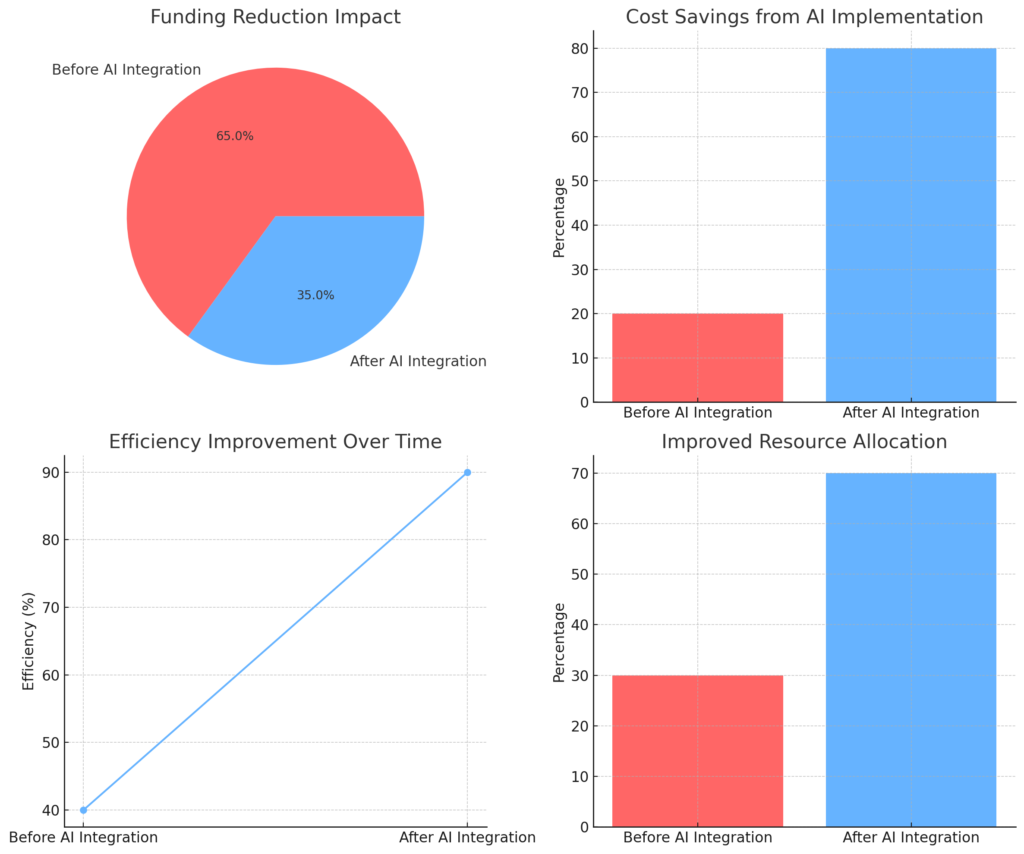
Can AI and Technology Save NGOs in the EU from Funding Cuts?
In recent years, organizations across the European Union have faced a harsh reality: funding cuts that put essential environmental and humanitarian projects at risk. The European Union has long been a significant source of funding, but recent policy shifts and economic pressures have led to shrinking budgets. One of the most significant blows came when former U.S. President Donald Trump decided to cut the budget from the global NGO fund, drastically reducing support and creating a ripple effect worldwide. As a result, many are scrambling to maintain efficiency while minimizing costs. The challenge is clear: Do more with less. This is where technology steps in. Implementing AI and automation has shown potential to reduce operational costs by up to 30% in some cases, allowing teams to reallocate resources to mission-critical tasks.
More and more organizations are turning to technology to bridge the gap left by reduced funding. AI, automation, and data-driven approaches are enabling them to maintain impact without stretching their limited resources too thin. Here’s how innovative solutions are helping them stay effective.
Here’s how innovative solutions are helping them stay effective.
1. Data Collection and Analysis Made Easy
One of the most resource-intensive tasks for environmental NGOs is gathering and interpreting data. Traditionally, this meant manual data collection and extensive human involvement. Arboretica’s innovative solutions streamline this process by automating the collection of environmental data points. With minimal human input, NGOs can obtain real-time, accurate insights, saving both time and money.
2. Automated Reporting and Compliance
Staying compliant with environmental regulations can be daunting. Automated reporting tools can simplify data aggregation and analysis, allowing NGOs to meet legal obligations with minimal effort. Arboretica’s automated systems excel at compiling reports that meet EU standards, ensuring that NGOs can continue their work without getting bogged down in bureaucracy.
3. Smarter Decision-Making with Predictive Analytics
Anticipating environmental changes and preparing proactive strategies are essential to making the most of limited funding. AI-driven predictive analytics allow organizations to make data-backed decisions. This empowers teams to allocate resources more intelligently and prioritize impactful projects, maximizing the impact of every euro spent.

Enhanced Collaboration and Communication
Effective collaboration is crucial for teams working across borders and sectors. Technology-driven platforms make sharing data and insights easier, fostering transparent communication. By integrating collaborative features, these solutions help connect stakeholders, even when resources are tight.
Examples: Leveraging AI to Overcome Funding Challenges
To better understand how technology is making an impact, here are a few real-life examples of how organizations have successfully integrated AI and automation into their operations:
- Wildlife Conservation Society (WCS): The WCS implemented AI-driven automated reporting to track wildlife populations and analyze habitat changes. This streamlined data processing allowed them to produce accurate reports faster, minimizing human intervention and cutting costs. The integration of AI technology enabled WCS to maximize the use of their available resources. (https://newsroom.wcs.org/News-Releases/articleType/ArticleView/articleId/13593/A-New-Cloud-Platform-Unveils-the-Most-Diverse-Camera-Trap-Database-in-the-World.aspx)
- Nature Policy Tracker (by Arboretica): This tool leverages AI and open-source intelligence to collect and analyze environmental data from diverse sources. It enables organizations to monitor policy changes efficiently, reducing manual workload and increasing accuracy. This data-driven approach helps maintain operational efficiency even with limited resources.(https://www.arboretica.com/blog/nature-based-solutions-policy-tracker/)
- Greenpeace Monitoring Systems: Greenpeace has implemented machine learning algorithms to monitor illegal deforestation activities in the Amazon. By processing satellite images and identifying areas of concern, the system significantly reduces manual monitoring efforts and allows rapid response to environmental threats.(https://news.mongabay.com/2014/10/daring-activists-use-high-tech-to-track-illegal-logging-trucks-in-the-brazilian-amazon/)
- Oxfam’s Automated Donor Engagement: Oxfam uses AI-driven chatbots and communication tools to maintain consistent donor engagement without overwhelming their staff. This automated system helps build stronger relationships while freeing up human resources for critical tasks.(https://uplandsoftware.com/adestra/resources/campaign-of-the-month/oxfam-got-fundraising-head-start-automated-welcome-email/)
By adopting similar AI-driven solutions, organizations can overcome the challenges posed by funding cuts and continue to make a significant impact.

Embracing Technology to Sustain Impact
Funding cuts, especially those driven by political shifts like Trump’s decision to reduce the global NGO fund, have left many initiatives vulnerable .However, leveraging technology, particularly AI and automation, can help not just survive but thrive. By adopting digital solutions and embracing innovation, organizations can continue to drive positive change despite financial constraints.
At Arboretica, we understand the importance of using technology to maintain environmental and social impact. Our solutions support organizations in maintaining environmental and social impact while staying committed to sustainability goals. Reach out to us to learn how we can help you make data-driven decisions and maintain impact in challenging times.


